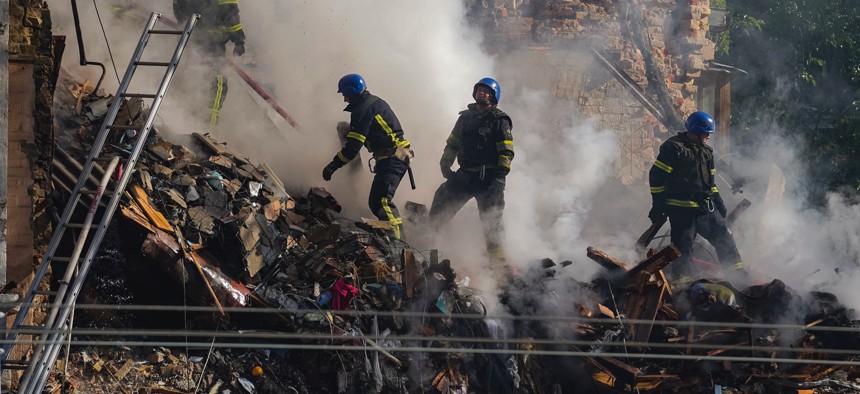MARCUS WEISGERBER

Drones and cruise missiles increasingly threaten the United States and its allies, the Biden administration said in its new assessment of global missile threats.
Released on Thursday, the Missile Defense Review arrives as kamikaze drones are being increasingly used in the conflict in Ukraine.
Drone “usage will likely expand and continue to pose a threat to U.S. personnel overseas, Allies and partners, and potentially to the U.S. homeland,” the report states.
Missile defense assessments conducted by the Trump administration in 2019 and the Obama administration in 2010 did not single out drones, also called uncrewed aircraft systems.
Drones “are an inexpensive, accessible, flexible, expendable, and plausibly deniable way to carry out armed attacks and project outsized power over a variety of domains,” the report states. “Accelerating technology trends continue to transform applications of UAS, making them increasingly capable platforms in the hands of both state and non-state actors.”
Russia has used Iranian drones to attack Ukrainian infrastructure. Meanwhile the U.S. has supplied Ukraine with Switchblade kamikaze drones, also known as loitering munitions. Drones have also been used to attack Saudi oil refineries.
Drones “can have similar lethality to cruise missiles and can launch from a wide array of locations, virtually undetected,” the report states. They “are generally not perceived by adversaries as having the same destabilizing geostrategic implications as larger missile forces, making them an increasingly preferred method to carry out tactical-level strikes.”
The Pentagon will “commit to examining technical solutions” to defeat drones and cruise missiles, a senior defense official said Thursday before the review’s public release.
Numerous defense companies showed off counter-drone technology during the Association of the U.S. Army’s annual meeting and exposition in Washington earlier this month.
“Russia has been indiscriminately using thousands of offensive missiles in Ukraine, and mainly not for precision military effects, but instead has broad area terror weapons to inflict terrible hardships on innocent civilians,” the senior defense official said. “Their use of missiles in Ukraine shows we should expect these weapons to become a common feature of 21st Century conflict.”
The Missile Defense Review also noted the threat posed to the U.S. mainland from cruise missile attacks and called for developing “active and passive defenses against regional hypersonic missile threats.” Hypersonic weapons can fly faster than five times the speed of sound and maneuver, much like a cruise missile. The Pentagon will “pursue a persistent and resilient sensor network to characterize and track all hypersonic threats, improve attribution, and enable engagement,” the report states.
The review also endorses building an elaborate defensive shield to protect Guam, a major logistical hub and base for U.S. military aircraft and ships, from a Chinese missile attack. The report also declares that an attack on Guam would be met with the same response to an attack on the U.S. mainland.
The Missile Defense Review can be seen as “a step forward from past reviews in several respects,” said Tom Karako, a missile defense expert at the Center for Strategic and International Studies.
“It corrects several inadequacies of the 2019 review, including insufficient attention to integration, air defense layering for cruise missile and [drone] threats, and survivability,” he said. “Although the public version of the review leaves some things to be desired, it advances several critical mission areas: a comprehensive approach to missile defeat, homeland cruise missile defense, the defense of Guam, and distributed operations.”
No comments:
Post a Comment